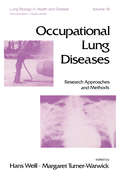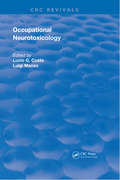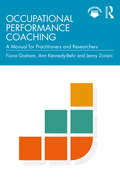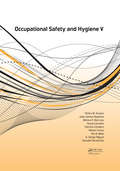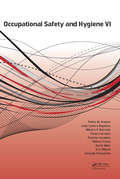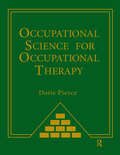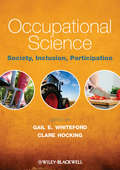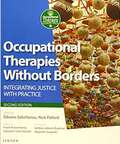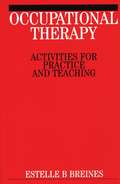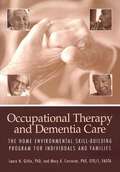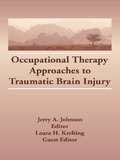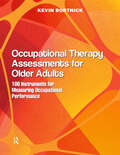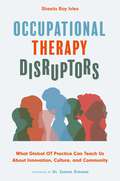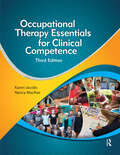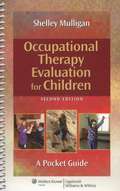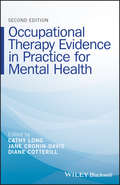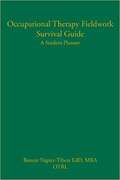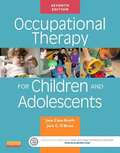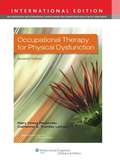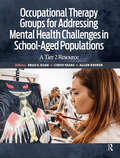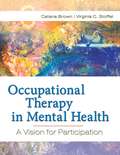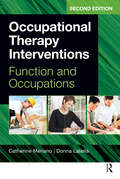- Table View
- List View
Occupational Lung Diseases: Research Approaches and Methods
by H. WeillThis book discriminates and emphasizes approaches that are likely to be productive in terms of understanding the causation and mechanisms of occupational lung diseases. It benefits research academicians in the field of lung diseases, and government and public health authorities.
Occupational Neurotoxicology (Routledge Revivals)
by Lucio G. Costa Luigi ManzoFirst published in 1988, many chemical compounds present in workplace settings can produce a number of impairments in the human nervous system. As the situations in which neurotoxic agents have been recognized in exposed workers has grown, so has the importance of occupational neurotoxicology as a specialty. Addressing some of the most vital concerns in the field, Occupational Neurotoxicology discusses: Neurotoxic agents commonly encountered in the workplace Signs and symptoms of neurotoxicity and of the factors affecting neurotoxic effects Biological monitoring and the use of biomarkers Epidemiological methods and clinical approaches to occupational neurotoxicology The analysis of behavioral, electrophysiological, and imaging techniques in the diagnosis of neurotoxicity Occupational neurotoxicity in developing countries The evaluation and management of occupational illnesses due to neurotoxicityOccupational Neurotoxicology concisely covers important facts on the adverse effects of chemical, biological, and physical agents that can impair or alter the structure of the nervous system. Professionals and researchers in the fields of occupational medicine, toxicology, epidemiology, neurology, industrial hygiene, and psychology will all find relevant information on the health problems that can occur from exposure to neurotoxicants.
Occupational Performance Coaching: A Manual for Practitioners and Researchers
by Jenny Ziviani Fiona Graham Ann Kennedy-BehrThis book presents a definitive guide to understanding, applying, and teaching Occupational Performance Coaching (OPC). Grounded in principles of occupational therapy, person-centredness, and interprofessional frameworks of health and disability, this book will be of interest across health and rehabilitation professions. Supporting people affected by disability to do well and live the life they want is the ultimate outcome of all rehabilitation professionals, no matter where on the lifespan our clients sit. Coaching is increasingly recognised as highly effective in achieving this aim. This accessible manual provides case examples related to diverse health conditions alongside practitioner reflections. Uniquely, this manual presents coaching methods designed specifically for the rehabilitation environment. This book is a manual for practitioners, researchers, students, and lecturers interested in gaining a robust understanding of OPC methods, theoretical basis, and implementation. An e-Resource linked to the book provides access to video demonstrations, a podcast from Dr Graham, and downloadable materials including a self-assessment of OPC skills (OPC Fidelity Measure), templates for clinical work, and teaching presentation material.
Occupational Safety and Hygiene V: Selected papers from the International Symposium on Occupational Safety and Hygiene (SHO 2017), April 10-11, 2017, Guimarães, Portugal
by Pedro M. Arezes João Santos Baptista Rui B. Melo Mónica P. Barroso, Paula Carneiro, Patrício Cordeiro & Nélson Costa A. Sérgio Miguel & Gonçalo PerestreloOccupational Safety and Hygiene V contains selected contributions from the International Symposium on Occupational Safety and Hygiene (SHO 2017, 10-11 April 2017, Guimarães, Portugal). The contributions focus on a wide range of topics, including: - occupational safety- risk assessment- safety management- ergonomics- management systems- environmental ergonomics- physical environments- construction safety, and- human factors Occupational Safety and Hygiene V is mainly based on research carried out at universities and other research institutions, but also includes practical studies developed by OHS Practitioners within companies. Accordingly, this book will be a helpful text to get acquainted with the state-of-the-art in research in these domains, as well as with some practical tools and approaches that are currently used by OHS professionals worldwide.
Occupational Safety and Hygiene VI: Book chapters from the 6th International Symposium on Occupation Safety and Hygiene (SHO 2018), March 26-27, 2018, Guimarães, Portugal
by Pedro M. Arezes João Santos Baptista Monica P. Barroso Paula Carneiro Patrício Cordeiro Nelson Costa Rui B. Melo A. Sergio Miguel Gonçalo PerestreloOccupational Safety and Hygiene VI collects recent papers of selected authors from 21 countries in the domain of occupational safety and hygiene (OSH). The contributions cover a wide range of topics, including:- Occupational safety- Risk assessment- Safety management- Ergonomics- Management systems- Environmental ergonomics- Physical environment- Construction safety, and- Human factors Occupational Safety and Hygiene VI represents the state-of-the-art on the above mentioned domains, and is based on research carried out at universities and other research institutions. Some contributions focus more on practical case studies developed by OSH practitioners within their own companies. Hence, the book provides practical tools and approaches currently used by OHS practitioners in a global context.
Occupational Science for Occupational Therapy
by Doris PierceOccupational Science for Occupational Therapyarticulates how occupational science research produces unique insights into occupation and increases the effectiveness of occupational therapy interventions. This text illustrates the four key types of knowledge now being researched in occupational science: descriptive, relational, predictive, and prescriptive. This text also offers a comprehensive review of occupational science’s history of emergence from the needs and interests of occupational therapy, conflicting origins and intents, and ongoing development as a discipline within academia. In Occupational Science for Occupational Therapy, Dr. Doris Pierce and an outstanding group of occupational scientists explain how their discoveries build the science and support practice. A rich variety of methods and perspectives mark the work of these career scientists as they respond to the knowledge base needs of occupational therapy. This fully evidence-based text also brings the research experience alive for occupational therapy students, describing the passions, challenges, and choices that are the reality of research as an occupation. All research chapters discuss how findings build both science and practice, including learning supports in which students can try out research activities, explore assessment, or develop interventions. Most importantly, Occupational Science for Occupational Therapyprovides new and experienced practitioners a thorough exploration of the latest research in occupation-based practice.Occupational Science for Occupational Therapy synthesizes key works by occupational scientists, including a foreword by Dr. Elizabeth Yerxa, founder of the science. Occupational therapy and occupational science students, practitioners, and faculty will especially appreciate this book’s comprehensive coverage of work by current leaders of research on occupation-based practice.
Occupational Science: Society, Inclusion, Participation
by Clare Hocking Gail E. WhitefordOccupational Science: Society, Inclusion, Participation is the must have resource for occupational therapists, occupational scientists, students and researchers. The book begins with a comprehensive review of the current literature and the knowledge generated to date. Reasons for the field's limited impact are proposed, including its focus on individuals rather than groups and communities, its psychological view of occupation, and its narrow focus on socially approved occupations. Global realities such as poverty, anti-social behaviour and ageing populations are discussed and implications for action are considered. The second section of the books comprises a series of chapters that address the philosophical, theoretical and scientific bases that underpin and inform everyday decision making in occupational therapy practice. This is followed by a section on methodological and structural considerations. The concluding chapter offers a critical reflection on methods, strategies, values and relationships for the future, to achieve a relevant science that makes a difference to current occupational realities. Written by an internationally renowned team of contributors, this book offers a truly comprehensive critique of the field. Features • Internationally renowned Editors and contributors • First comprehensive text on occupational science • Fully up to date with the latest thinking and research • Links theory to practice
Occupational Therapies Without Borders: Integrating Justice With Practice (Occupational Therapy Essentials Series)
by Dikaios Sakellariou Nick PollardRead about justice in everyday practice; austerity across the world and how it affects people's lives; the impact of neoliberalism on health systems; eco-social occupational therapy; evaluation in community-based practice and many more in the new edition of Occupational Therapies without Borders, edited by Dikaios Sakellariou and Nick Pollard! A thought-provoking book, with 67 chapters and 150 authors from all over the world writing about the social and political aspects of occupation. This book aims to inspire occupational therapy students and practitioners to include transformational elements into their practice. <p><p> The new edition of this landmark international work builds on the previous two volumes, offering a window onto occupational therapy practice, theory and ideas in different culturesand geographies. It emphasizes the importance of critically deconstructing and engaging with the broader context of occupation, particularly around how occupational injustices are shaped through political, economic and historical factors.
Occupational Therapy Across Cultural Boundaries: Theory, Practice and Professional Development
by Susan Cook MerrillThis fascinating book examines the concept of culture from a unique perspective--that of individual occupational therapists who have worked in environments very different from those in which they were educated or had worked previously. In Occupational Therapy Across Cultural Boundaries, six occupational therapists relate their experiences living and working in a foreign culture. Each author describes the daily demands placed upon her through immersion into a different way of life and discusses the environmental challenges she had to overcome to be able to live and work successfully. Many of the cultural differences the authors faced forced them to reassess and reconstruct their most basic assumptions of both personal and professional life as they discovered that activities and theories common or applicable in one culture are not necessarily translatable into another. The authors also analyze culture across treatment areas in occupational therapy practice, including mental health and physical disability, with both adults and children.Both beginning and experienced occupational therapists and occupational therapy students will find much valuable information in Occupational Therapy Across Cultural Boundaries. Whether interested in examining occupational therapy’s application to non-Western cultures, or actually contemplating practicing in a different culture, readers will benefit from learning about the experiences of the authors. This unique book is also helpful for occupational therapy students wishing to examine the philosophy of occupational therapy or the significance of culture to human occupation. Professors will find it useful as an ancillary textbook for undergraduate and graduate courses in occupational therapy on topics such as theory, occupation across cultures, or meaningful activity.
Occupational Therapy Activities: Theory And Practice
by Estelle B. BreinesAt last, a book about the little pieces of occupation which make up life' s real situations and experiences and form a basis for therapy. Offered in the form of stories about practice previously published in the popular US publication Advance for Occupational Therapy Practitioners, this enjoyable book presents occupational therapists as "masters of the mundane." Therapists, students and educators will find this easy to read text a useful tool in guiding clinical approaches to therapy. Accompanied by theoretical papers by Dr. Estelle Breines and colleagues previously published in refereed international journals, these stories will aid the reader in understanding principles of active occupation that guide practice and shed light on how these ideas can be applied to the education of therapists.
Occupational Therapy And Dementia Care: The Home Environmental Skill-building Program For Individuals And Families
by Laura N. Gitlin Mary Corcoran American Occupational Therapy Association StaffDementia is a progressive, terminal disease that currently affects more than 4 million adults in the United States. This number is expected to increase to 13 million people in the near future as the Baby Boom generation reaches retirement age. Suppporting people with dementia and their families in managing the disease and maximizing their quality of life is complex, requiring a multidisciplinary team approach among health and human services professionals. Although new understanding of the etiology of dementia is emerging with hope for treatment on the horizon, we remain in need of approaches for helping people with dementia and their families in caregiving. <P><P> This book presents one approach--the Home Environmental Skill-Building Program, which has been rigorously tested over the past 15 years--and is designed principally for occupational therapists and, in particular, practitioners at the intermediate and advanced levels. In addition, graduate students in occupational therapy as well as other health and human services professionals will find this guide useful for understanding the role and impact of the physical and social environment in dementia care, the strategies that can minimize environmental stressors in the home, and the unique role of occupational therapists in management of the disease and caregiver concerns.
Occupational Therapy Approaches to Traumatic Brain Injury
by Laura H Krefting Jerry A JohnsonThis sensitive book provides a much-needed compilation and description of OT programs for the care of individuals disabled by traumatic brain injury (TBI). Focusing on the disabled individual, the family, and the societal responses to the injured, this comprehensive book covers the spectrum of available services from intensive care to transitional and community living. Both theoretical approaches to the problems of brain injury as well as practical treatment techniques are explored in Occupational Therapy Approaches to Traumatic Brain Injury. The processes of assessment and intervention are vital to the recovery of brain-injured patients and this thorough book devotes two chapters specifically to assessment and several chapters on intervention and family involvement. This useful volume contains information about rehabilitation from ‘coma to community,’as well as numerous other approaches.The findings and treatment suggestions presented here are applicable to many helping professionals working with TBI patients. Health care practitioners working with brain injured persons and their families in both institutional and community contexts, physical therapists, physicians, nurses, and psychologists and social workers involved with assessment will find this an invaluable addition to their professional references.
Occupational Therapy Assessments for Older Adults: 100 Instruments for Measuring Occupational Performance
by Kevin BortnickThe role of measurement and the benefits of outcome measures are defined as important tools used to document change in one or more constructs over time, help to describe a client’s condition, formulate a prognosis, as well as to evaluate the effects of occupational therapy intervention.Occupational Therapy Assessments for Older Adults: 100 Instruments for Measuring Occupational Performance presents over 100 outcome measures in the form of vignettes that encompass a brief description of each instrument, a review of its psychometric properties, its advantages and disadvantages, administration procedures, permissions to use, author contact information, as well as where and how to procure the instrument. Occupational Therapy Assessments for Older Adults by Dr. Kevin Bortnick narrows down the list of possible choices for the occupational therapy student or clinician to only those with an amount of peer review, bibliographic citations, as well as acceptance within the profession. The text also includes research-based information with text citations and has over 100 tables, diagrams, and figures. Included in the review of each outcome measure: Description: A brief record of the measure. Psychometrics: A review of the level of research evidence that either supports or does not support the instrument, including such items as inter-rater, intra-rater, and test-retest reliabilities, as well as internal consistencies and construct validities among others. Advantages: Synopsis of the benefits of using the measure over others including its unique attributes. Disadvantages: A summary of its faults. For example, the amount of research evidence may be limited or the measure may be expensive. Administration: Information regarding how to administer, score, and interpret results. Permissions: How and where to procure the instrument, such as websites where it may be purchased or journal articles or publications that may contain the scale. Summary: A brief summation of important information. Occupational Therapy Assessments for Older Adults: 100 Instruments for Measuring Occupational Performance encourages occupational therapy and occupational therapy assistants to expand their thinking about the use of appropriate outcome measures with older adult populations. Using the appropriate outcome measure based on evidence can aid in the promotion of health, well-being, and participation of clients.
Occupational Therapy Disruptors: What Global OT Practice Can Teach Us About Innovation, Culture, and Community
by Sheela Roy IvlevThis anthology collates 16 unique and powerful perspectives from occupational therapists around the globe, each highlighting the culture that they are a part of and how it informs their work and care. Ranging across almost every continent in the world including stories from Aotearoa to the Gaza Strip to Dhaka and beyond, Occupational Therapy Disruptors offers a decolonised re-examination of occupational therapy through a poignant, global lens.Based on a series of interviews conducted by Sheela Roy Ivlev, each account provides candid and personal reflections and challenges found in occupational therapy in different cultural and political contexts and inspires occupational therapists to enrich their own practice with cultural awareness and reflexivity.With reflection prompts and calls to action at the end of each chapter, this is an invaluable resource for occupational therapists looking to develop a more diverse, culturally-informed understanding of their practice.
Occupational Therapy Essentials for Clinical Competence
by Karen Jacobs Nancy MacRaeOccupation, theory-driven, evidence-based, and client-centered practice continue to be the core of the profession and are the central focus of Occupational Therapy Essentials for Clinical Competence, Third Edition.The Third Edition contains updated and enriched chapters that incorporate new perspectives and evidence-based information important to entry-level practitioners. The Third Edition continues to relate each chapter to the newest ACOTE Standards and is evidence-based, while also addressing the guidelines of practice and terms from the AOTA’s Occupational Therapy Practice Framework, Third Edition.Dr. Karen Jacobs and Nancy MacRae, along with their 61 contributors, introduce every topic necessary for competence as an entry-level practitioner. Varied perspectives are provided in each chapter with consistent references made to the relevance of certified occupational therapy assistant roles and responsibilities.Additionally, chapters on the Dark Side of Occupation and Primary Care have been added to broaden the foundational scope of knowledge. Each chapter also contains a clinical case used to exemplify relevant content.New in the Third Edition: All chapters have been updated to reflect the AOTA’s Occupational Therapy Practice Framework, Third Edition Updated references and evidence-based practice chart for each chapter Updated case studies to match the current standards of practice References to the Occupational Therapy Code of Ethics (2015) Faculty will benefit from the multiple-choice questions and PowerPoint presentations that coincide with each chapter Included with the text are online supplemental materials for faculty use in the classroom.Occupational Therapy Essentials for Clinical Competence, Third Edition is the perfect multi-use resource to be used as an introduction to the material, while also serving as a review prior to sitting for the certification exam for occupational therapists and occupational therapy assistants.
Occupational Therapy Evaluation For Children: A Pocket Guide (Second Edition)
by Shelley E. MulliganMaster the skills and concepts necessary to effectively perform efficient evaluations of children with Occupational Therapy Evaluation for Children: A Pocket Guide, 2nd Edition. Reflecting the latest AOTA standards, this pocket-sized guide is a quick,comprehensive reference you can use throughout your education and into practice.
Occupational Therapy Evidence in Practice for Mental Health
by Cathy Long Diane Cotterill Jane Cronin-DavisOccupational Therapy Evidence in Practice for Mental Health is an accessible and informative guide to the application of theory and the evidence-base to contemporary clinical practice. Fully updated throughout, chapters cover a range of mental health issues, approaches and settings, including service user and carer involvement, group work, services for older people, interventions, forensic mental health, and managing depression. Key Features Written by an expert author team, drawing on a wide range of evidence, service contexts, national policy and legislation. Focus on person-centred practice in mental health services. Each chapter also contains a variety of learning features, including task boxes, reflective questions and further readings, to aid understanding and demonstrate the use of evidence to inform clinical decision-making. The second edition of this easy-to-read and practical textbook is an ideal resource for occupational therapy students, clinical practitioners, and anyone looking for a concise, accessible guide to evidence-based practice and how it informs occupational therapy in mental health.
Occupational Therapy Fieldwork Survival Guide: Strategies For Success
by Lee Haroun Bonnie Napier-TibereThis planner leads students step-by-step toward making a smooth transition from classroom to clinic. It serves as an organizational tool to shift their focus from themselves and their academic grades to the needs of clients/patients.
Occupational Therapy For Children And Adolescents
by Jane Case-Smith Jane O'BrienThe sixth edition of Occupational Therapy for Children maintains its focus on children from infancy to adolescence and gives comprehensive coverage of both conditions and treatment techniques in all settings. Inside you'll discover new author contributions, new research and theories, new techniques, and current trends to keep you in step with the changes in pediatric OT practice. This edition provides an even stronger focus on evidence-based practice with the addition of key research notes and explanations of the evidentiary basis for specific interventions.
Occupational Therapy For Physical Dysfunction
by Mary Vining Radomski Catherine A. Trombly LathamSucceed in the course and master the concepts and skills you need to be an effective, reflective practitioner with Occupational Therapy for Physical Dysfunction, 7th Edition. The authors introduce the highly acclaimed, easy-to-understand Occupation Functional Model (OFM) in the first section, setting the stage for subsequent discussions that guide you through the assessment and treatment of adult patients with physical dysfunction from initial evaluation to treatment to follow-up. Featuring engaging and practical coverage, the Seventh Edition includes the latest research in the field, new activity analysis case examples, new photos, new online videos, and a streamlined organization that includes 45 chapters in the print textbook with three additional chapters posted online.tables that highlight the psychometric properties and the strengths and weaknesses of individual assessment methods.
Occupational Therapy Groups for Addressing Mental Health Challenges in School-Aged Populations: A Tier II Resource
by Brad Egan Cindy Sears Allen KeenerA new resource for school-based occupational therapists, Occupational Therapy Groups for Addressing Mental Health Challenges in School-Aged Populations: A Tier 2 Resource is a collection of occupation-based group interventions and tools that can be used to support students at risk for or with identified mental health challenges.School-wide mental health programs are increasing and expanding. School-based occupational therapists are uniquely positioned to collaborate with traditional school mental health practitioners and provide an occupational perspective on how mental health can impact school performance and participation in academic occupations.Occupational Therapy Groups for Addressing Mental Health Challenges in School-Aged Populations is organized into different sections to assist the occupational therapy practitioner or occupational therapy student in considering different aspects of providing mental health services in schools. The text serves as a flexible compendium of group activities and interventions designed to promote positive mental health for all students and support students at risk for or with identified mental health challenges.What’s included in Occupational Therapy Groups for Addressing Mental Health Challenges in School-Aged Populations: Cases to help recognize the occupational impact of internalizing and externalizing behaviors A quick reference of common assessments and screening tools Occupation-based Tier 2 group protocols and data collection tool templates An online section for occupational therapy and occupational therapy assistant educators with ideas for learning assignments, rubrics, and classroom activities to prepare prelicensure learners for addressing school mental health needs once they enter practice Occupational Therapy Groups for Addressing Mental Health Challenges in School-Aged Populations: A Tier 2 Resource expresses the valued contribution that occupational therapists make to school mental health initiatives while also addressing a major gap—a Tier 2–focused resource with intervention ideas and tools for answering this urgent call to practice.
Occupational Therapy In Community And Population Health Practice
by Marjorie E. Scaffa S. Maggie ReitzThe New Edition reflects the convergence of community and population health practice with expanded content on health promotion, well-being, and wellness. Drs. Scaffa and Reitz present the theories underpinning occupational therapy practice in community and population health. Then, the authors provide practical guidance in program needs assessment, program development, and program evaluation. Both new practitioners and students will find practice-applicable coverage, including expanded case examples, specific strategies for working in the community, and guidance on securing funding for community and population health programs.
Occupational Therapy In Mental Health: A Vision For Participation
by Catana Brown Virginia C. Stoffel Jaime Phillip MunozThis Client-centered, recovery-oriented text gives voice to the lived experience of mental illness across the life span. You will be guided through the assessment and interventions of individuals with mental health conditions and those whose life circumstances generate significant challenges to their participation in valued activities.
Occupational Therapy In Mental Health: A Vision For Participation
by Catana Brown Virginia C. Stoffel Jaime MunozUses the Person-Environment-Occupation (PEO) model as a framework to promote the full participation in the lives of individuals with mental illness and those struggling with psychosocial issues related to their disabilities. <p><p> Features first-person “The Lived Experience," narratives that give voice to the experience of living with a mental illness <p> Incorporates “Photo Voice” features, a blend of photography and personal stories that enable individuals to record their visions and experiences to promote dialogue about important issues. <p> Addresses co-occurring conditions such as depression, stroke, substance abuse and spinal cord injury, and attention deficit disorder and learning disabilities. <p> Promotes best practices with “Evidence-Based Practice “boxes that synthesize significant research and implications for practice. <p> Offers extensive information on theory and evidence-based interventions <p> Employs active learning strategies to facilitate the application of knowledge, skills, and attitudes essential for mental health and psychosocial interventions. <p> Addresses occupational therapy in a variety of practice settings for individuals from all cultures across the life span. <p> Discusses non-diagnosis-based populations, such as the homeless, as well as the continuum of care from institution or hospital to the community.
Occupational Therapy Interventions: Function and Occupations
by Catherine Meriano Donna LatellaOccupational Therapy Interventions: Functions and Occupations, Second Edition is a unique and comprehensive text intended to provide the essential information required for occupational therapy practice in the physical approach to the intervention process. This practical and user-friendly text offers an entry-level approach to bridging the American Occupational Therapy Association’s Occupational Therapy Practice Framework,Third Edition with everyday practice, specifically concerning interventions.Dr. Catherine Meriano and Dr. Donna Latella focus each chapter of the text on an area of occupation, evidence-based practice, current intervention options, as well as a specific hands-on approach to grading interventions. Although the focus of the text is the intervention process, Occupational Therapy Interventions: Function and Occupations, Second Edition also includes a detailed “Evaluation Grid” which offers a unique approach to choosing occupational therapy evaluations.New in the Second Edition: New evidence-based articles have been added to each of the chapters Some new rewritten and expanded chapters Updated references throughout Includes sample exam questions with each chapter Updated key concepts and incorporated new documents such as: AOTA’s Occupational Therapy Practice Framework,Third Edition AOTA’s Occupational Therapy Code of Ethics AOTA’s Guidelines for Supervision, Roles, and Responsibilities During the Delivery of Occupational Therapy Services Included with the text are online supplemental materials for faculty use in the classroom.With the incorporation of new evidence-based concepts, updates to reflect the AOTA’s newest documents, and new hands-on approaches to interventions, Occupational Therapy Interventions: Functions and Occupations, Second Edition should be by the side of every occupational therapy student and entry-level practitioner.
